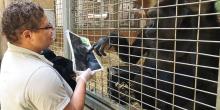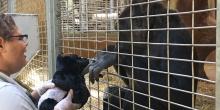#GorillaStory: Communicating with Calaya


Many of the animals at the Smithsonian’s National Zoo learn basic husbandry behaviors that help keepers evaluate their health and well-being. Behaviors vary depending on the species and individual personalities of the animals, but often include presenting body parts for inspection, shifting from one location to another and participating in minor medical procedures, such as vaccinations and blood draws.
To encourage the animals to do these behaviors, keepers use a training technique called operant conditioning. Animals voluntarily participate in training sessions, and they receive a reward when they do the specific behavior asked of them. These rewards come in the form of food and verbal praise, often a hearty “good job!” This positive reinforcement helps build trust between an animal and his or her keeper.
When western lowland gorilla Calaya first arrived at the Zoo, she was unfamiliar with many husbandry behaviors. Keepers tried many strategies to encourage Calaya, but she remained cautious and reluctant to participate.
“For about a year, Calaya had no interest in fully participating in training sessions with anyone on the primate team,” said animal keeper Melba Brown. “I would try to put her at ease by sitting close by and talking to her, but her attitude was quite gruff.”
Then, one day, Brown had an ‘aha’ moment. She noticed that Calaya would often watch other gorillas interact with keepers.
“During a training session with our silverback, Baraka, I asked him to present his back,” says Brown. “Calaya was watching him do the task and receive a grape for his participation. When we finished and he walked away, Calaya walked up to the mesh, looked at me and presented her back. I was so shocked! I rewarded her with lots of grapes, and we became fast friends.”
This was the second time that Calaya had initiated an interaction with Brown; she clearly had earned Calaya’s trust. Recognizing that Calaya learned best by observing others was just the breakthrough Brown needed to train Calaya.
“When she initiated contact with me, it was such a dramatic and unexpected gesture, but it was a key development in our relationship,” says Brown. “She mastered some behaviors in the span of a day—she was a genius! Now, we are able to expand upon those basic behaviors for more complicated maternal training, such as presenting her belly for ultrasounds and presenting her chest to ‘nurse’ a plush gorilla toy.”
This story appears in the December 2017 issue of National Zoo News. Follow the Zoo’s updates throughout Calaya’s pregnancy on Facebook, Twitter and Instagram with the hashtag #gorillastory.

